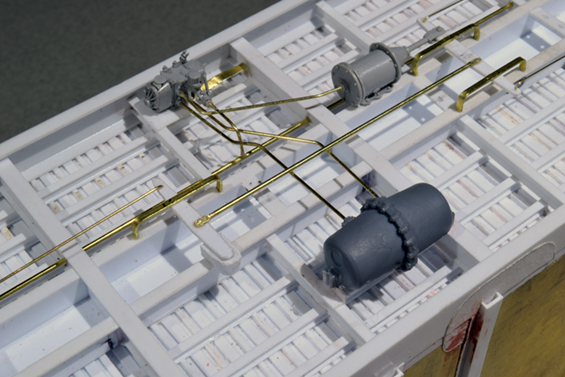If you’ve ever built anything in this craft you understand that the smaller and finer the details, the more time consuming they are to do. I had the three brake components installed for several weeks but have held off on the piping and rodding because I was thoroughly intimidated by all those brackets, fulcrums and pieces going everywhere.
I’ll be the first to say that some of these details are wrong for a car of this era. Quarter-inch scale is married to the 1950s and modern details are hard to find or nonexistent. In this case, the brake cylinder in the upper right is too old for a 1970s vintage freight car. I could have put out a call for help with 3D printing of the right parts but I didn’t want to wait. In a niche like modern era P48, one does what one can. I probably could have modified the San Juan brake cylinder but chose not to in order to move the project forward. So, I’m now firmly in the danger zone.
The Danger Zone is the stage where you just want to get the thing done and move on to something else. I find that thought going through my head a lot as I finish up the smallest and most fragile details on the car. I’m really fighting the urge to rush the work, make compromises and move on the primer and paint. The car is so, so close to being finished. It only needs a line to the retainer valve and a bracket, the doors and associated hardware, four jacking pads, the air hoses and uncoupling levers, then it’ll be ready for primer, painting and weathering.
To fight the tendency to rush and compromise the remaining work, I constantly remind myself of all the effort I’ve put into the car to this point. I push away from the bench and think of all the blog posts I’ve written about the high art of craftsmanship and what a total fraud I’ll look like if I just slop on the last few pieces.
Is the car perfect? No. There are plenty of mistakes and poorly handled details. The next project won’t be perfect either. Perfection isn’t the goal, learning something new and enjoying the process is the true objective in this work. So, even though the details may be off a lot or a little in the photo above, I’m really jazzed that all of those pieces of wire are in place. I’ve pushed myself with this car and have an ongoing opportunity to continue learning as I reach the finish line.
Regards,
Mike

Good morning Mike
It’s photos like this one that really speak to the reason “why” for larger scale modeling. There are so many layers of rich detail and visual texture to enjoy here. I often read about how in O the modeler can render details that might be too small in, say N, but it’s the way the parts appear on the car that I’m most impressed with here – I find I’m looking through detail to see other.
Well done. Nice work.
Chris
It once took me longer to remove the excess paint accumulated by spraying too closely and for too long, than it did to scratchbuild the blessed vehicle in the first place…
Lesson (festina lente) learned!
Simon
Mike, I must admit to not even considering such advancements in the basic elements of cars from the 50’s to now, if the brakes have worked fine all this time then why would they make changes. I’m not sure most of us would notice so much and/or find the wrong fitting a problem so bravo for making that allowance. As for perfection, it is, for me, nothing more than a state of mind, finding a level of satisfaction at a given point in time is more relevant. I think I would compare this to the classic car hobby where the owners of Concours de Elegance vehicles load them into trailers and drag them to shows to win awards and praise but never ever drive them, it is really just a car, drive it! And so with your box car, once it is mucked up and on the rails I know your 1/4 inch consignees won’t give a hoot what parts were used to get to their door.
David
Hi David,
While I’m not an expert at all, my understanding is that the various appliances have changed in capacity to accommodate the forces of longer, heavier modern trains, even as the basic design of the brake system is the same. The brake cylinder on this car is of a different design than the steam era part I used. As mentioned in the text, it was a choice made to move the project forward and I’m not losing any sleep over it. Every model is a reflection of your knowledge and skill at a moment in time. It’s part of the process of making choices and learning new abilities to apply toward the next model.
Regards,
Mike